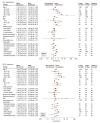Characteristics Associated With Racial/Ethnic Disparities in COVID-19 Outcomes in an Academic Health Care System
- PMID: 33084902
- PMCID: PMC7578774
- DOI: 10.1001/jamanetworkopen.2020.25197
Characteristics Associated With Racial/Ethnic Disparities in COVID-19 Outcomes in an Academic Health Care System
Erratum in
-
Errors in Table, Figure Legend, and the Supplement.JAMA Netw Open. 2021 Aug 2;4(8):e2126218. doi: 10.1001/jamanetworkopen.2021.26218. JAMA Netw Open. 2021. PMID: 34398209 Free PMC article. No abstract available.
Abstract
Importance: Black patients are overrepresented in the number of COVID-19 infections, hospitalizations, and deaths in the US. Reasons for this disparity may be due to underlying comorbidities or sociodemographic factors that require further exploration.
Objective: To systematically determine patient characteristics associated with racial/ethnic disparities in COVID-19 outcomes.
Design, setting, and participants: This retrospective cohort study used comparative groups of patients tested or treated for COVID-19 at the University of Michigan from March 10, 2020, to April 22, 2020, with an outcome update through July 28, 2020. A group of randomly selected untested individuals were included for comparison. Examined factors included race/ethnicity, age, smoking, alcohol consumption, comorbidities, body mass index (BMI; calculated as weight in kilograms divided by height in meters squared), and residential-level socioeconomic characteristics.
Exposure: In-house polymerase chain reaction (PCR) tests, commercial antibody tests, nasopharynx or oropharynx PCR deployed by the Michigan Department of Health and Human Services and reverse transcription-PCR tests performed in external labs.
Main outcomes and measures: The main outcomes were being tested for COVID-19, having test results positive for COVID-19 or being diagnosed with COVID-19, being hospitalized for COVID-19, requiring intensive care unit (ICU) admission for COVID-19, and COVID-19-related mortality (including inpatient and outpatient). Medical comorbidities were defined from the International Classification of Diseases, Ninth Revision, and International Classification of Diseases, Tenth Revision, codes and were aggregated into a comorbidity score. Associations with COVID-19 outcomes were examined using odds ratios (ORs).
Results: Of 5698 patients tested for COVID-19 (mean [SD] age, 47.4 [20.9] years; 2167 [38.0%] men; mean [SD] BMI, 30.0 [8.0]), most were non-Hispanic White (3740 patients [65.6%]) or non-Hispanic Black (1058 patients [18.6%]). The comparison group included 7168 individuals who were not tested (mean [SD] age, 43.1 [24.1] years; 3257 [45.4%] men; mean [SD] BMI, 28.5 [7.1]). Among 1139 patients diagnosed with COVID-19, 492 (43.2%) were White and 442 (38.8%) were Black; 523 (45.9%) were hospitalized, 283 (24.7%) were admitted to the ICU, and 88 (7.7%) died. Adjusting for age, sex, socioeconomic status, and comorbidity score, Black patients were more likely to be hospitalized compared with White patients (OR, 1.72 [95% CI, 1.15-2.58]; P = .009). In addition to older age, male sex, and obesity, living in densely populated areas was associated with increased risk of hospitalization (OR, 1.10 [95% CI, 1.01-1.19]; P = .02). In the overall population, higher risk of hospitalization was also observed in patients with preexisting type 2 diabetes (OR, 1.82 [95% CI, 1.25-2.64]; P = .02) and kidney disease (OR, 2.87 [95% CI, 1.87-4.42]; P < .001). Compared with White patients, obesity was associated with higher risk of having test results positive for COVID-19 among Black patients (White: OR, 1.37 [95% CI, 1.01-1.84]; P = .04. Black: OR, 3.11 [95% CI, 1.64-5.90]; P < .001; P for interaction = .02). Having any cancer was associated with higher risk of positive COVID-19 test results for Black patients (OR, 1.82 [95% CI, 1.19-2.78]; P = .005) but not White patients (OR, 1.08 [95% CI, 0.84-1.40]; P = .53; P for interaction = .04). Overall comorbidity burden was associated with higher risk of hospitalization in White patients (OR, 1.30 [95% CI, 1.11-1.53]; P = .001) but not in Black patients (OR, 0.99 [95% CI, 0.83-1.17]; P = .88; P for interaction = .02), as was type 2 diabetes (White: OR, 2.59 [95% CI, 1.49-4.48]; P < .001; Black: OR, 1.17 [95% CI, 0.66-2.06]; P = .59; P for interaction = .046). No statistically significant racial differences were found in ICU admission and mortality based on adjusted analysis.
Conclusions and relevance: These findings suggest that preexisting type 2 diabetes or kidney diseases and living in high-population density areas were associated with higher risk for COVID-19 hospitalization. Associations of risk factors with COVID-19 outcomes differed by race.
Conflict of interest statement
Figures



Update of
-
COVID-19 outcomes, risk factors and associations by race: a comprehensive analysis using electronic health records data in Michigan Medicine.medRxiv [Preprint]. 2020 Jun 18:2020.06.16.20133140. doi: 10.1101/2020.06.16.20133140. medRxiv. 2020. Update in: JAMA Netw Open. 2020 Oct 1;3(10):e2025197. doi: 10.1001/jamanetworkopen.2020.25197. PMID: 32793920 Free PMC article. Updated. Preprint.
References
Publication types
MeSH terms
Grants and funding
LinkOut - more resources
Full Text Sources
Medical
Miscellaneous

